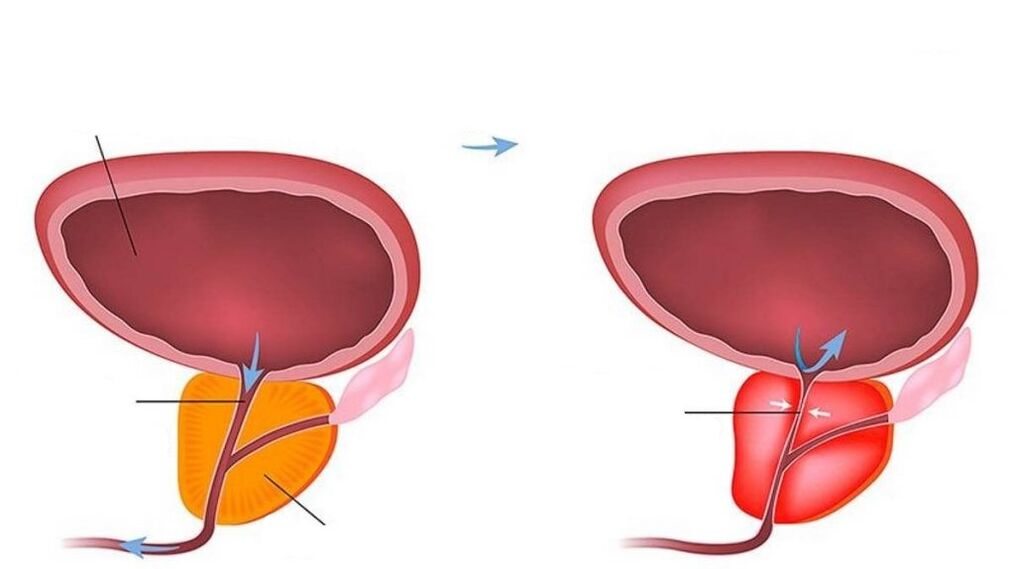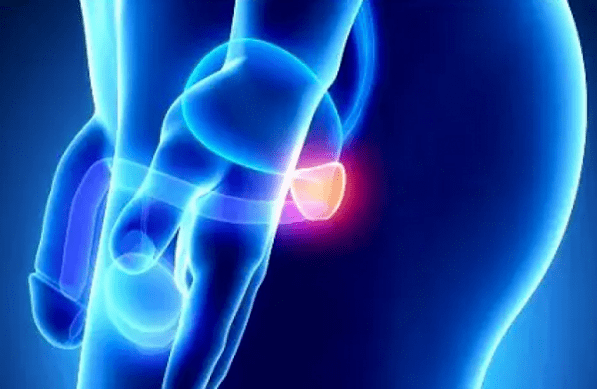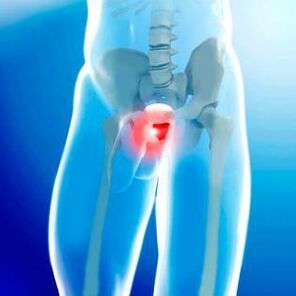Prostatitis is an inflammation of the prostate gland, also called the prostate. This disease can occur for the following reasons:

- Infection.
- Bacteria.
- Virus.
- Fungus.
- Long -term use of antibiotics, leads to decreased immunity.
In many cases, the infection enters the body through sexual intercourse. As a result, stagnation occurs in the pelvic organs and blood circulation is weakened.
There are also non -communicable reasons why chronic prostatitis can develop:
- Non -settled lifestyle.
- Improper structure of the prostate gland.
- Damage to the perineum.
- Congenital pathology.
- Swelling of the prostate gland.
- Low testosterone levels.
- Tough physical energy.
- Hypothermia.
- Stress and nervous tension.
The emergence of this pathology may also be due to the development or ineffective treatment of the disease:
- Sinusitis.
- Kidney stones.
- Angina.
- Inflammation of the urethral canal.
In addition, prostatitis can occur due to inconsistent sexual activity and periodic disturbances, which contribute to the development of stuck processes.
Some facts to keep in mind:
- To maintain a healthy prostate, you need to have sex at least twice a week.
- There is no need to delay urination (this not only contributes to the development of stagnation, but also affects the potency).
- Regular consumption of tobacco and alcohol harms the prostate gland, so do not abuse them.
How can you tell if the prostate gland is inflamed?
The manifestations of prostatitis can vary significantly depending on the stage of development of the disease. There are 3 levels:
- Discomfort appears in the lower abdomen. Often you want to empty your bladder (with a burning sensation).
- The problem starts in the genital area (erection worsens, pain is felt at the time of ejaculation, ejaculation occurs prematurely).
- In the last stage, the body temperature rises, pain occurs when urinating, the patient shivers.
Important: if we talk about chronic prostatitis, then in this case the development of pathology, as a rule, is not accompanied by appropriate symptoms (or manifestations of the disease are weakly expressed). The danger of this form is that exacerbations can begin at any time.

Treatment of chronic prostatitis with folk remedies
There are many traditional methods used to treat prostatitis. Immediately, we say that each method we describe below should be used only after prior consultation with a doctor. Remember that medications on their own are not only ineffective, but can also make the problem worse.
In addition, you need to understand that folk remedies do not allow you to completely get rid of chronic prostatitis. It is logical to use it for disease prevention or as an aid, along with medications and physiological procedures prescribed by a doctor.
garlic
Garlic is considered quite effective for the prevention and treatment of chronic prostatitis. Recipe:
- Take a few cloves of garlic.
- Throw into a container (e. g. a thermos) and pour a quarter of a liter of boiling water.
- Drink before bed on an empty stomach.
There are also other recipes:
- Take three reviews.
- Pour 200 ml of cold milk.
- Boil over low heat and cook for one minute.
- Insist for half an hour.
- Take 35 drops four times a day after meals.
Boil the onion skin
Recipe:
- Peel an onion and rinse.
- Pour into a saucepan and pour half a liter of hot water.
- Boil for 5 minutes and leave for 60 minutes.
- Take one teaspoon three times a day.
Intake of a combination of golden mustache balm and asparagus juice
To prepare the balm, you need:
- Mix 150 ml of golden mustache alcohol extract with 500 grams of linseed oil.
- Place in a closed container.
- Shake for 5-7 minutes.
You need to drink this balm for 10 days three times a day for one teaspoon, after that for another 5 days, use asparagus juice as many times, 2-3 tbsp. l. Repeat the cycle twice.
Warm the prostate gland using birch tar
You need to take 3 tbsp. l tar and pour with 3 liters of boiling water. Then sit on this mixture for 7-10 minutes. This technique is effective in the early stages of prostatitis. It should not be used if there are hemorrhoids or venereal disease.

Aspen bark tincture
Immediately, we say that the collection of bark should be done in early spring, when the leaves on the tree have not yet bloomed. This is very important, because during this period it is most saturated with juice, which gives a healing effect. Collect bark no more than 5 mm thick.
Recipe:
- Grind 100 g of dry skin.
- Fill with vodka until it covers the bark completely.
- Insist for 14 days, then strain.
- Drink 15-20 ml orally three times a day for a month.
The texture is Ivan
Recipe:

- Grind ivan tea leaves and pour hot water in the rate of 1 tbsp. l. each glass.
- Insist for 40 minutes.
- Clean the ingredients from the infusion and use one tablespoon daily.
Other recipes involve the use of not only leaves, but also flowers. They need to be poured with a glass of boiling water. The infusion is prepared overnight. You need to take it twice a day for half a glass.
Aloe colored wine with honey
Aloe and honey are products that are widely used in traditional medicine. To prepare a cure for prostatitis, you need:
- 0, 5 kg of aloe vera leaves (plants must be at least 3 years old).
- The same amount of honey.
- Half a liter of red wine (preferably dry).
You need to mix all these ingredients and insist for 5 days in a dark, dry place. For the prevention of prostatitis, you should drink 1 tablespoon 2-3 times a day. l. throughout the month. Next, you need to rest 7 days and repeat the course.
Bath lotion and soda
Soda helps to combat infections that occur during prostatitis. Baths and lotions are prepared according to the same recipe. You need to dilute the soda with boiling water in the rate of 1 tbsp. l. per liter. Before starting the procedure, it is necessary to let the solution cool slightly.
Propolis texture
Prepared according to this recipe:
- Crushed propolis should be poured with pure alcohol in a ratio of 1 to 2.
- Place the medicine in a dark and not hot place.
- Enter for 14 days, shaking from time to time.
- Strain at the end.
The drug must be taken on an empty stomach three times a day, mixed with warm milk. Proportion: 15 drops of tincture per 100 grams of milk.
Color on the roots and leaves of ginseng
10 units of ginseng requires 1 unit of alcohol diluted with water in a ratio of 1 to 1. Insist for several days. Drink once a day. This recipe is not recommended if you suffer from insomnia or high blood pressure.
Alcohol infusion of aralia root
Aralia has many beneficial nutrients, which among others have a positive effect on the condition of the prostate gland. But the problem is that this crop grows mainly in eastern countries (Mongolia, China, Korea). In our latitudes, it is quite difficult to get aralia roots.
If you are successful, here is a recipe for making color:
- Pour 20 g of root with 70% alcohol in a volume of 100 ml (vodka will also work).
- Insist for several days.
- Drink 10 drops 3 times a day.
This drug is effective not only for prostatitis. This also provides an opportunity to overcome sexual dysfunction. However, if there is cardiovascular disease, this infusion cannot be used.
Dill infusion on port wine
Mix 100 g of pharmaceutical dill with 1 liter of port. The drug must be available within 3 weeks. Drink half a glass before eating. Tingcture reduces inflammation of the prostate gland.
A mixture of walnuts and honey
For a long time, nuts have been used to restore male strength. To prepare a cure for prostatitis, you must:
- Cut 5 beans.
- Add half a glass of honey.
- Stir well.
Consumption at the beginning of the day for 1 tbsp. l.
Tea and chamomile bath
To make chamomile tea, you need to pour 200 ml of boiled water in 1 tbsp. l. the plant is dried and insisted for several hours. Eat three times a day on an empty stomach. This medicine allows you to overcome the infection and relieve the inflammation.
Bath with chamomile infusion is prepared as follows:
- 5 tablespoons. Pour dried chamomile with hot water.
- We boil for a few minutes and cook for about 2 hours.
- Add to the bathtub while showering.
Chestnut shell tea
Remove the shells from the chestnuts. Fill with hot water, boil for a few minutes and use in it. The taste of the drink is not very pleasant, so you can add a little honey.
Bathroom with pine needles
You need to boil the branches of coniferous trees (ideally pine) and pour into the bathroom. The water temperature should not exceed 38 ° C. Raw materials can be collected independently, or can be purchased at the pharmacy.
Pumpkin seeds
The last folk remedy for prostatitis on our list is pumpkin seeds. They should be eaten daily in 30 pieces. Helps both prevent the development of pathology and reduce symptomatic pain.
Can prostatitis go away on its own?
Don’t even hope that prostatitis will go away on its own. This is unlikely to happen even in the first stage. If the right measures are not taken, the disease will only progress and, as a result, develop into chronic.
See your urologist immediately if you experience any symptoms. He will give you the necessary medicine. Also, the treatment of prostatitis, as a rule, involves physical education and proper nutrition. In some cases, immunomodulators and antidepressants are prescribed.
What are the dangers of prostatitis and how does it manifest itself?
Determining the presence of inflammatory processes in the prostate is quite simple. Prostatitis does not pose a serious danger to human life. However, without qualified medical treatment, the pathology can cause serious difficulties, thus limiting life.
If the prostate is inflamed, then this causes discomfort in the perineum and in the lower back. The disease is often accompanied by pain. It can be painful and sharp. In particular, pain is relevant for men who do not have sexual intercourse permanently.
If there is an infection, mucus or pus may appear in the discharge. If treatment is not started on time, this will eventually lead to a decline in sperm quality.
Can chronic prostatitis be completely cured?
Prostatitis treatment statistics show that recurrence is recurrent. In many cases, the recurrence of the disease is due to the fact that the patient does not have enough resilience to completely eliminate the pathology.
Of course, the treatment of prostatitis requires a lot of patience and significant financial costs. So, for example, if there is an infection and the doctor prescribes antibiotics, then it can not be stopped halfway, even if the disease has stopped feeling. If you do not complete the course of drug treatment, then the pathogenic agent will recover after a few seconds and, moreover, become immune to the drugs you are taking.
Thus, although relapses often occur in chronic prostatitis, the patient’s condition is self -reliant. If you really follow the doctor's recommendations, then the signs of inflammation will not make themselves feel long, and may even disappear forever.
Tests for prostatitis
In all cases, if prostatitis is suspected, the following procedure is prescribed:
- Blood tests - make it possible to identify inflammation by checking leukocyte levels and erythrocyte sedimentation rate (ESR).
- Urine analysis - performed several times. Allows you to determine increased levels of bacteria and white blood cells.
- Study of prostate secretion - allows early detection of prostatitis, prostate cancer and infertility.
- Urine culture - allows you to determine the sensitivity of the bacteria that cause prostatitis, thus choosing the right antibiotic.
If prostatitis is chronic, 4 glasses of urine are taken. This test makes it possible to understand exactly where the infection is located. The analysis was performed as follows:
- The patient fills the first tube with urine.
- After that, urination continued on the 2nd.
- The doctor massages the prostate. The salient secret is considered the 3rd test.
- The urine residue that came out after the massage was the 4th sample.
Further laboratory tests were performed:
- If bacteria are found in the 3rd or 4th part, this means that the prostatitis is bacterial.
- If more than 10 leukocytes are also present in the same sample, then there is inflammation of the prostate gland.
- If there are more than 10 leukocytes, but the bacterial flora is normal, then this may indicate the presence of chlamydia and other infections.
In the latter case, abrasions of the urethra and mucous membranes are taken, which makes it possible to detect sexually transmitted microorganisms.
In some cases, with digital rectal examination, there is a suspicion of adenoma and prostate cancer. This condition is the reason for the diagnosis, in which a blood test is taken to measure the level of PSA (a prostate -specific agent).
Note: PSA sampling was performed no earlier than 10 days after rectal examination.
What examination is done to diagnose prostatitis
For the treatment of prostatitis, antibiotics, antibacterial (non-steroidal) drugs, as well as drugs that enhance immunity and increase blood supply can be used. However, it is impossible to prescribe the most effective drug therapy without early diagnostics, which makes it possible to understand the form of the disease.
Traditionally, ultrasound examination (ultrasound) is performed if acute prostatitis is suspected. With this method, doctors can:
- Determine the volume and density of the prostate.
- Find out if the plexus of the prostate vein is enlarged.
- Look for signs of abscesses.
In some cases, endoscopy is prescribed, but in acute prostatitis, this method is contraindicated.
If prostatitis is accompanied by neurogenic urinary disorders, then the following procedures may also be prescribed:
- Introduction of catheter probes to determine and record urethral pressure profile.
- Myography, which allows you to assess the work of the pelvic floor muscles.
- CT and MRI, if there are prerequisites for prostate cancer or non -inflammatory prostatitis.
In the framework of conservative treatment, laser therapy, herbal medicine, magnetotherapy, electrophoresis, mud baths and many other procedures can be prescribed. If this approach is not effective, then surgery is required.
Types of ultrasound examination for various forms of prostatitis
According to statistics, in about 80% of cases of chronic prostatitis, the disease -causing particles cannot be detected through laboratory tests. However, palpation also does not allow us to rely on an accurate diagnosis, as obvious structural changes do not always occur in the prostate gland.
Although associated with chronic infectious prostatitis, bacteriological analysis is sometimes not much information. Diagnostic errors, as a rule, are due to the fact that microbes accumulate in the tissues, but they do not enter the secretions, which are taken in the laboratory.
In this case, ultrasound is almost always prescribed along with the analysis. This procedure makes it possible not only to identify changes in the prostate gland, but also to dynamically monitor the improvements that occur during treatment.
In modern diagnostics, two types of ultrasound are used:
- Fixtures.
- Transabdominal.
Each of these techniques has unique advantages and disadvantages.
Transrectal method
In this case, an ultrasound machine is inserted into the patient’s rectum. This method provides excellent visualization and allows you to gather the most complete information about the condition of the prostate gland.
Contraindications:
- Hemorrhoids and anal fissures.
- Postoperative recovery period.
- Benign and malignant tumors.
Transabdominal method
The prostate is examined through the anterior abdominal wall. This method allows you to determine the size and boundaries of the gland, as well as the symmetry of the lobes. The disadvantage of such ultrasound is that not every hospital uses equipment whose quality makes it possible to obtain reliable information about the condition of tissues.
What are the possible consequences if there is no treatment for prostatitis?
If prostatitis is not treated, then it can lead to such complications:
- Prostate gland abscess, requires immediate hospital treatment and surgery.
- The formation of cysts and stones in the prostate, causes severe pain and requires long -term treatment.
- Vesiculitis (inflammation of the seminal vesicles), which is only treated in hospital.
- Prostate sclerosis, which causes urinary problems.
- Infertility.
What is the purpose of prostate massage?
Prostate massage is a procedure performed in all cases of chronic prostatitis, except calculus prostatitis. He was also appointed in a situation like this:
- If there is no orgasm.
- In case of impotence.
- For diagnostic purposes (allows you to detect inflammatory processes).
Many men have a certain prejudice against prostate massage, unknowingly recognizing it as homosexual. In fact, this procedure allows you to prevent the development of prostatitis, remove infected secretions, prevent the development of stagnant processes, improve blood circulation and increase male potency, improve the quality of sexual intercourse.
However, there are situations where prostate massage cannot be done:
- Severe inflammation of the prostate gland.
- Tumors (both benign and malignant).
- Infections of the genitourinary system.
- Hemorrhoids and anal fissures.
- An unusual form of prostatitis.
- Tuberculosis of the prostate.
- Urinary incontinence.
- Exacerbation of chronic prostatitis.
Does chronic prostatitis interfere with normal sex and conception?
Chronic prostatitis usually has no sexual problems. But it also happens in other ways. It is well understood that inflammation of the prostate gland causes discomfort (not only physical, but also psychological). Painful sensations can make it difficult for men to have intimate intercourse with a partner. At the same time, psychological factors can cause erection problems.
Separately, it should be said about the infectious form of chronic prostatitis. In this situation, during sexual intercourse, there is a risk of spreading bacteria or fungi to the partner.
Advice: if you decide to get pregnant, make sure you are tested and make sure there is no infection. If found, carry out treatment.
Why is it important to have a regular sex life with prostatitis?
For the normal functioning of the body, it is important to ensure that all its needs are met. The condition of the prostate gland has a significant effect not only on sexual activity, but also on the ability to conceive. This is due to the fact that the secretions produced in the prostate are the part of sperm responsible for the viability and activity of sperm.
When inflammation of the prostate occurs, metabolic processes in the glandular cells are accelerated, as a result of which toxins are released, which accumulate in secretions. As a result, at the time of orgasm, these harmful substances leave the body along with the sperm, contributing to the normalization of the prostate and speeding up recovery.
There is another important point: with prostatitis, an inflammatory process occurs, due to which blood flow worsens. With sexual stimulation, the blood supply to the penis increases significantly, and at the time of ejaculation, the pelvic muscles contract. All this has a positive effect on the condition of the glands and helps to overcome prostatitis.
How likely is infertility in chronic prostatitis?
In the early stages, prostatitis is not a barrier to pregnancy. In some cases, there are erection problems caused by physiological and psychological factors. But with the right treatment and understanding on the part of the couple, the problem can be solved.
It is another matter if you ignore the presence of prostatitis for a long time. The development of pathology can lead to a decrease in sperm quality: sperm will become less active and unable to reach the point where fertilization occurs. Moreover, this problem is not always detectable with the results of the analysis.
If you suffer from prostatitis and are unable to give birth, see your doctor. In addition to a course of treatment aimed at eliminating inflammatory and infectious processes in the prostate gland, as a rule, diet and vitamins are prescribed. Although they do not increase the chances of fertilization, they strengthen the immune system, which helps prevent the formation of new infections.
What to do if you are unable to conceive for a long time?
Doctors say that in normal situations, fertilization should occur within a year after regular and unprotected sexual intercourse. If not, you need to see a doctor for a thorough examination.
A man is recommended to undergo the following procedure:
- Spermogram - allows you to determine the number of active sperm, as well as assess the chemical and physical composition of semen.
- Genital ultrasound - aims to study the structures responsible for the formation and excretion of sperm, as well as identify problems with the blood supply.
Various procedures are available for women:
- Assessment of basal temperature for 3 menstrual cycles, followed by scheduling.
- Genital ultrasound.
- Hysterosalpinography - photographs of the uterus and fallopian tubes to evaluate their anatomical structure and patents.
- Hysterosonography is an ultrasound examination of the uterine cavity.
- Blood tests to determine hormonal parameters in the endocrine system.
In some cases, problems with conception arise due to the incompatibility of the partner. To determine the presence of this problem, postcoital testing is prescribed and genetic screening is performed.



























